What is an HR Knowledge Base?
An HR Knowledge Base is a centralised place for all of a company's HR-related information like time-off policies, perks, etc. It's also synonymous with the HR Handbook.
Traditionally, companies would give out chunky textbooks to every new hire on their first day. Now HR Handbooks are much more functional, and well, handy. For remote-first/hybrid companies, an HR Handbook (or a version of it) lives in their Knowledge Base software.
Here's ours!
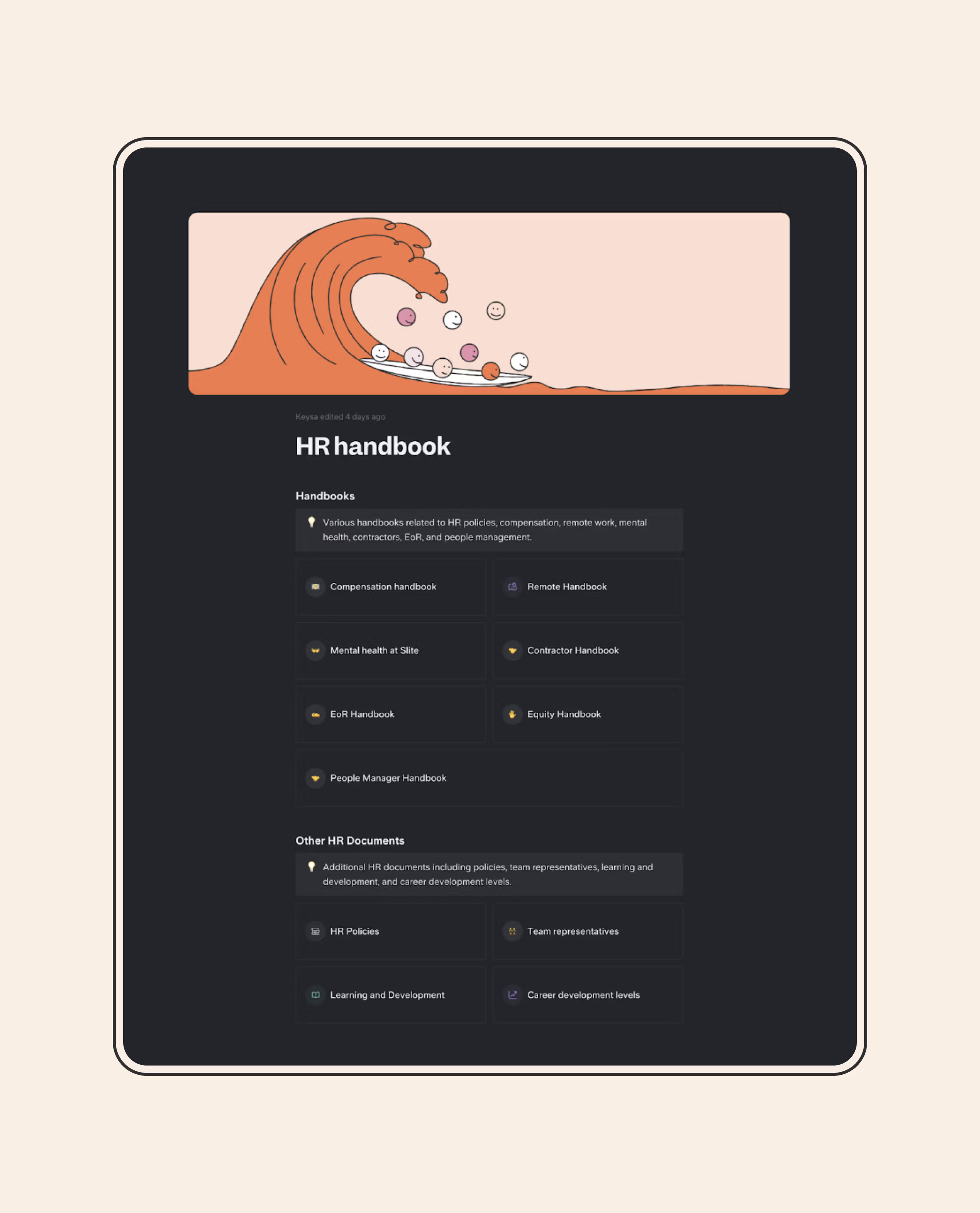
Looks neat? Get this as a free template here.
What are the benefits of an HR Knowledge Base?
An HR Knowledge Base benefits both the HR team and other teams because it reduces repetitive questions, productivity loss, and improves writing culture.
An HR Knowledge Base is a new joinee's best friend. Not only is it important to catch them up - but now there's new, unconventional reasons to build it:
Drastically improves employee experience
People find themselves with less patience to ruffle through nested docs, especially if they're middle management on back-to-back calls. They'd much rather just DM the HR team because it's faster for them. But asking repetitive questions slows your HR team.
Now, they have to look up the same response, and repeat it to you again. If you follow a lean hiring philosophy, it means that your HR headcount is minimal already. And you want to ensure that information retrieval doesn't cost time for anyone.
When you create an HR Knowledge Base, you offset your HR team’s dependency on information flow.
HR Folks can invoke their KB to answer for them, even in Slack.
If teams have an intelligent HR Knowledge Base, it means the end of quick questions. Especially the ones during focus work. HR Knowledge Bases - like Slite - have AI search features to answer people's questions based on verified company information. Moreover, Slite's Search can be invoked without disrupting anyone’s workflow - be it your Chrome browser, Slack, or even while writing a doc.
For example, this article is being written on Slite now. It's one of my deep work blocks. If I were to suddenly remember that I have to take off tomorrow, I don't have to open Slack to text my team. I don't even have to try navigating to the right doc. I just have to press Cmd + K and I'll get this:
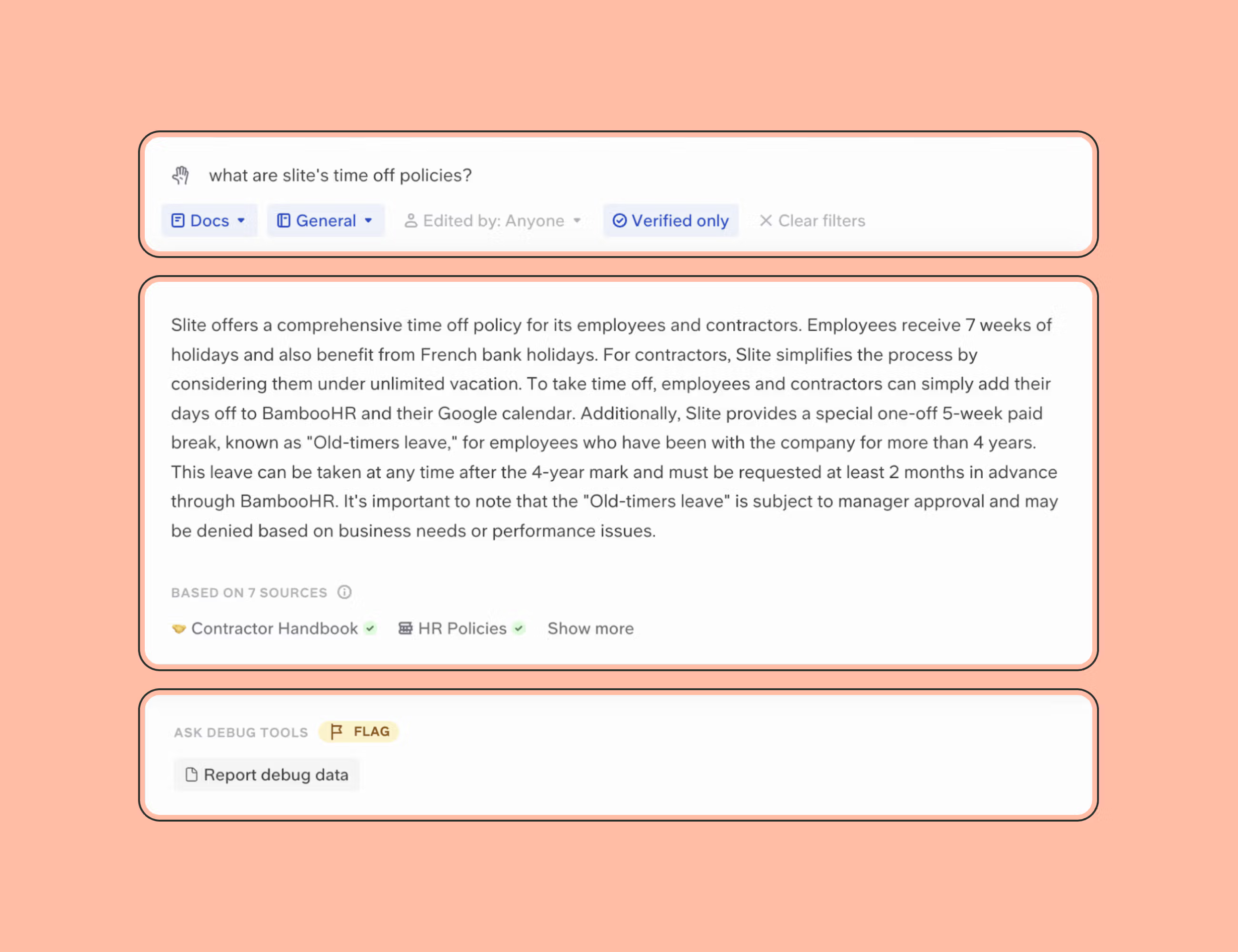
Slite even gives me the option to copy the answer and share it as an image - if I needed to send it to a coworker.
Easier to know which policy needs to be updated
Great Knowledge Base tools give you a feature to verify your docs up to a custom time. For example, renewing your time-off policy for the year of 2024 - 2025. You might update it today but how will you remember to update it next year too?
To solve this exact problem, a lot of Knowledge Base tools give you features to verify your docs till whenever you want them.
Improves employee engagement during onboarding
A good onboarding experience shows your team’s attention to detail since first impressions last a long time. And an onboarding experience becomes good if it has room for exploration and self-service. Your HR Knowledge Base will most likely be the second touchpoint for every employee after they’ve finished their onboarding checklist.
The easy way - Build your HR Knowledge Base using Slite’s free Wiki Generator
Step 1: Go to slite.com/wiki-generator

Step 2: Talk to it
You’ll be redirected to this page where Slite AI will ask you questions to generate a directory and a cascading wiki structure that can be easily used for navigating across docs by your team.
After you're satisfied with the structure, start filling those docs up! Feel free to move things around, change the cover, add in additional docs that are needed by your team.
The standard way - 5 steps to build an HR Knowledge Base
Here's how to build an HR Knowledge Base →
Step 0 - Select who's the long-term owner
Ownership is the real problem of Knowledge Bases. It doesn't matter what form your documentation comes in if there is no ownership of said documentation. If nobody is vested in maintaining one, your team members won't adopt it and they'll default to the next easiest step - DMing you.
That’s why you need a designated owner to champion this project and steer it in the right direction. This doesn't necessarily have to be an HR generalist, though they would be a natural choice. Maybe your team has a technical writer who could be on support and lead the initiative on an L1 level and be the lead contributor.
The key is finding someone who can be the central point of contact for all things.
Step 1 - Take inventory of your team's most asked questions
Conduct interviews with your team to identify the specific frustrations they encounter when seeking information. Analyse HR support tickets to see what common questions or confusions keep arising.
But there's many more areas where HR questions naturally emerge. Your Slack DMs, for instance. Which questions are you getting most often? Are there any links you have to keep sending repeatedly?
And if you’re suffering with the blank page syndrome, opt some of these most asked questions by employees worldwide:
- What's the employee referral policy?
- What are all my perks and where can I access them?
- What are my health insurance benefits and how do I use them?
- How much paid time off (PTO) do I have accrued? What is the company policy on using it?
- What are the steps for requesting leave (sick leave, parental leave, etc.)?
- What is the company dress code? (Especially important if you're working from office)
- What is the process for filing a harassment or discrimination complaint?
- How do I get reimbursed for work-related expenses?
- What are the company's policies on remote work or flexible work arrangements?
- Where can I find information about upcoming training and development opportunities?
- Where can I find information about performance reviews and appraisal cycles?
- What's the culture around team communication for the company?
Step 2 - Make it search-able, trust-able, and navigable
A user should be able to navigate through your docs, search for specific answers when in a hurry, and most importantly, can take the written word as fact, without need for double-checking.
Search-able
When designing your Knowledge Base, think about how employees will naturally search for information. Don't just rely on keyword stuffing or overly complex taxonomies. Use a tool with a powerful search function that understands synonyms, natural language, and can handle misspellings.
Eg: Slite users can search for answers on Slack, their browser tabs, or virtually anywhere else.
Trustable:
Employees need to have confidence that the information they find in the Knowledge Base is accurate and up-to-date. Clearly mark the verification status of every doc so your team (and you!) know when it needs a little refreshing.
Navigable:
A well-organised structure is key. Categorise content intuitively, with clear navigation menus and breadcrumbs that allow users to find their way around easily. Think about incorporating faceted navigation that allows users to filter content by topic, department, document type, or other relevant criteria.
Step 2.5: Connect your HR knowledge beyond the knowledge base
While building a searchable HR knowledge base is essential, modern HR teams face a challenge that traditional knowledge bases can't solve: critical HR information lives everywhere. Your policies might be perfectly documented in your knowledge base, but salary discussions happen in Slack, benefits questions are answered in support tickets, performance review templates live in Google Drive, and compliance updates are scattered across email threads.
This fragmentation means employees still waste time hunting through multiple platforms, and HR teams get interrupted with questions that were already answered somewhere - just not in the right place. Even with the best knowledge base, employees often can't find complete answers because context is missing from different tools.
That's why our team built Super.work as Slite's companion - an AI-powered enterprise search platform that connects all your company tools into one intelligent interface. Instead of employees hunting through your HR knowledge base, Slack, email, and Google Drive separately, they can ask natural language questions like "What's our parental leave policy?" or "How do I submit expenses?" and get comprehensive answers with source citations from across all platforms.
This creates a complete HR knowledge system: Slite for structured HR documentation, Super for unified search across your entire information ecosystem. Your carefully crafted HR policies become even more accessible when they're discoverable alongside real-time discussions and decisions happening everywhere else. At $15 per user per month, Super ensures no critical HR information gets lost in tool silos, making your HR knowledge base truly comprehensive.
Step 3 - Make it a collaborative build
Building a comprehensive HR Knowledge Base isn't a solo act for HR. Collaborate with subject matter experts (SMEs) outside HR for accurate content creation. For instance, involve your Finance team for payroll explanations or Legal for compliance sections.
To ensure the content is clear and jargon-free for all employees, get a non-HR person to be your "plain language" proofreader. Before a full launch, conduct a pilot test with a select group of employees from different departments. Observe how they interact with the Knowledge Base and gather feedback on its usability.
Step 4: Ship it
Running your Knowledge Base is just the beginning. Build in a feedback mechanism and actively solicit employee input about their experience using the Knowledge Base. What worked well? What information is missing? Leverage analytics to see what search terms are successful and which ones yield no results. Use this data to identify areas for content improvement. Publicly recognize those who contribute valuable content to the Knowledge Base. This gamifies knowledge sharing and encourages ongoing participation.
Step 5: Set up a maintenance cadence
Keeping your Knowledge Base up-to-date is essential. Clearly define who's responsible for content updates (is it solely HR's responsibility, or are other departments involved?). Establish a system for regular reviews. Build a process to ensure new policies or legal changes are immediately reflected in the Knowledge Base. This keeps the Knowledge Base an accurate and reliable source of information.
What content should you include in your HR Knowledge Base?
You should include all content related to perks, salary, policies, training, reviews, and hiring. Here's how our content structure would look if we were to redo it today:
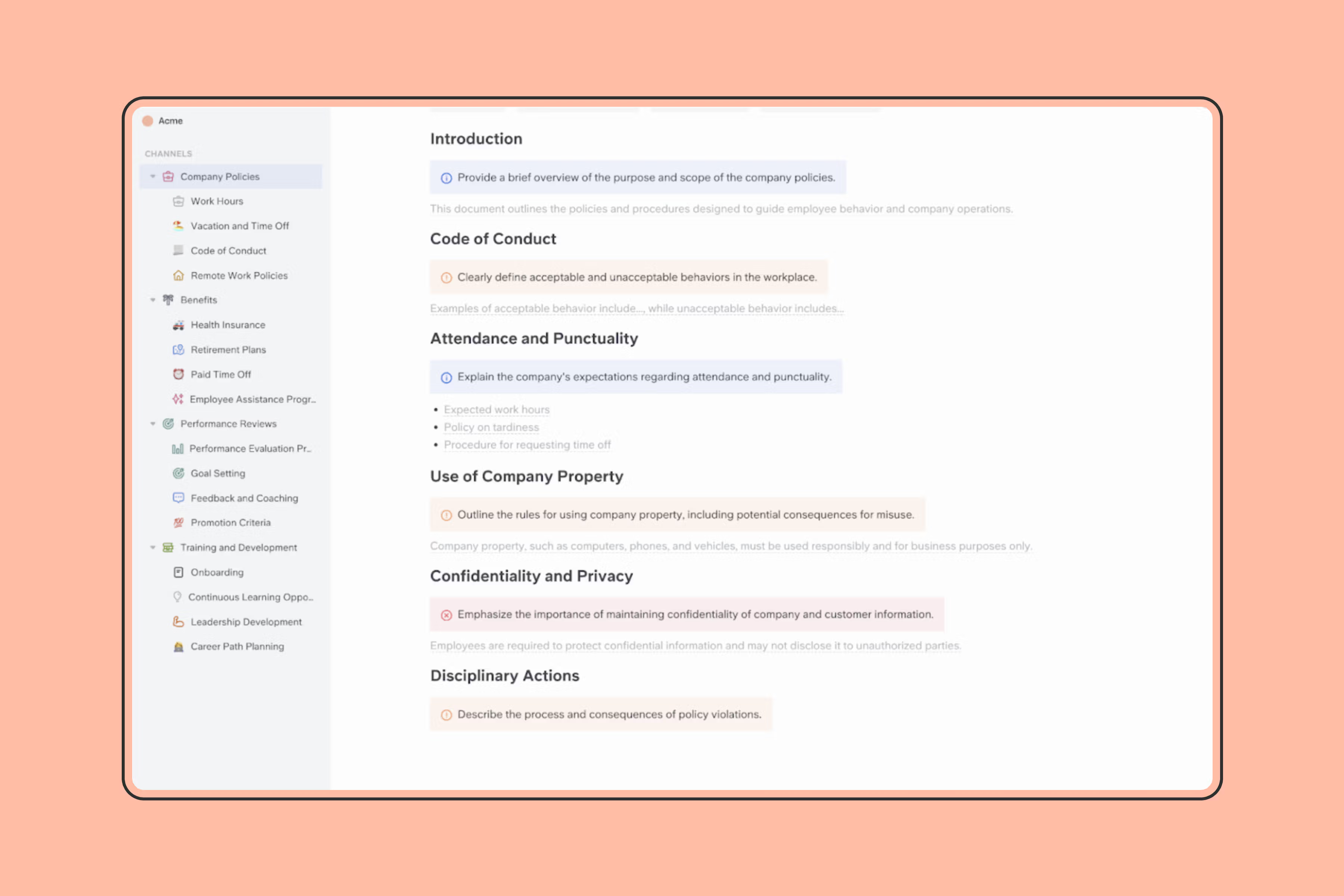
Want AI to build an exact wiki structure like this for free in the next 5 minutes? Use Slite's Wiki Generator.
5 non-writing-related tips to 10x your HR Knowledge Base
Tip 1 → Add videos, illustrations, and pictures. A lot of them.
A picture says a thousand words, a wise man once said. And he was right. It's painful - and lengthy - to explain some things in text. Imagine not being able to use screenshots/screen recordings/Excalidraw for a day. Wouldn't it be harder for you to explain things or report bugs?
If we use different formats in our Slack messages and Mail, we should 100% be using it in our Knowledge Bases.
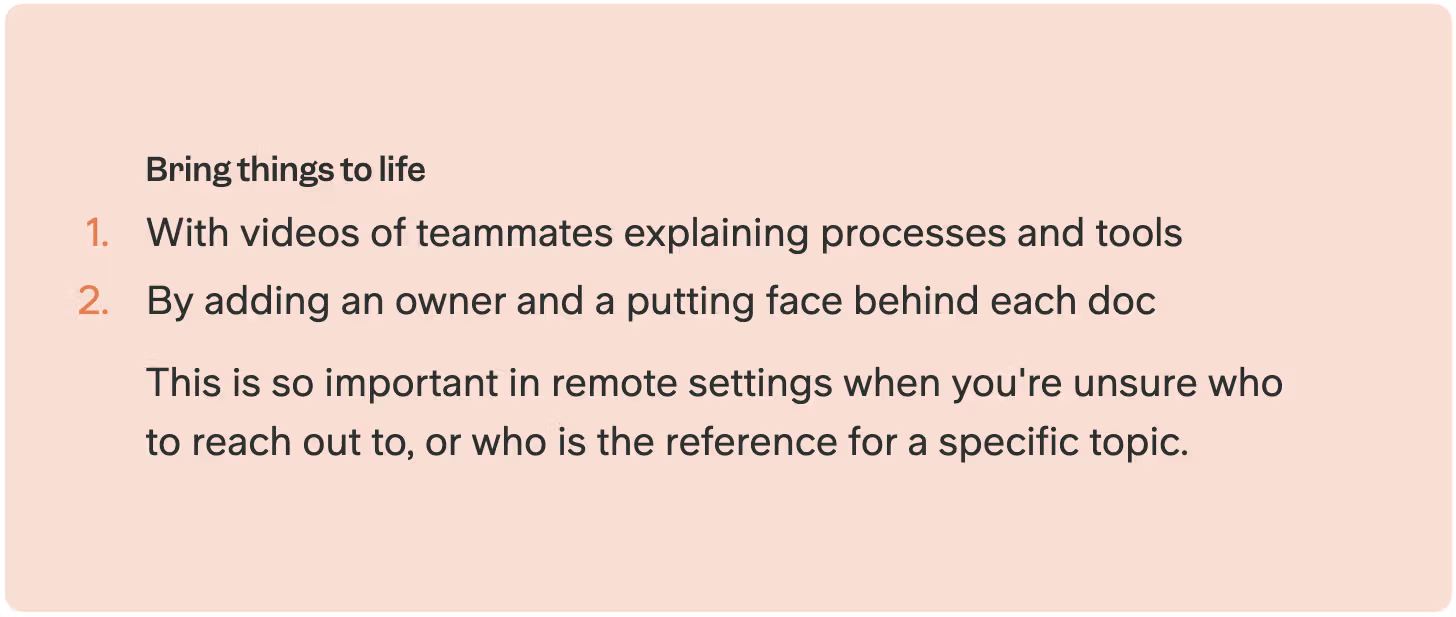
Tip 2 → Make verification tags compulsory*
When you verify a doc, it pops up in all search results. Employees don't have to second-guess without trusting the info. While it should be there for all types of Knowledge Bases, it's extra important to have verification tags for your HR Knowledge base.
Picture an employee accidentally spending 2x of their corporate card limits because of outdated info, or maybe trying to log into the wrong portal after you recently shifted it.
Outdated info can have a very real cost when it comes to HR. At Slite, we have a thumb rule to verify every single HR doc for exactly this reason.
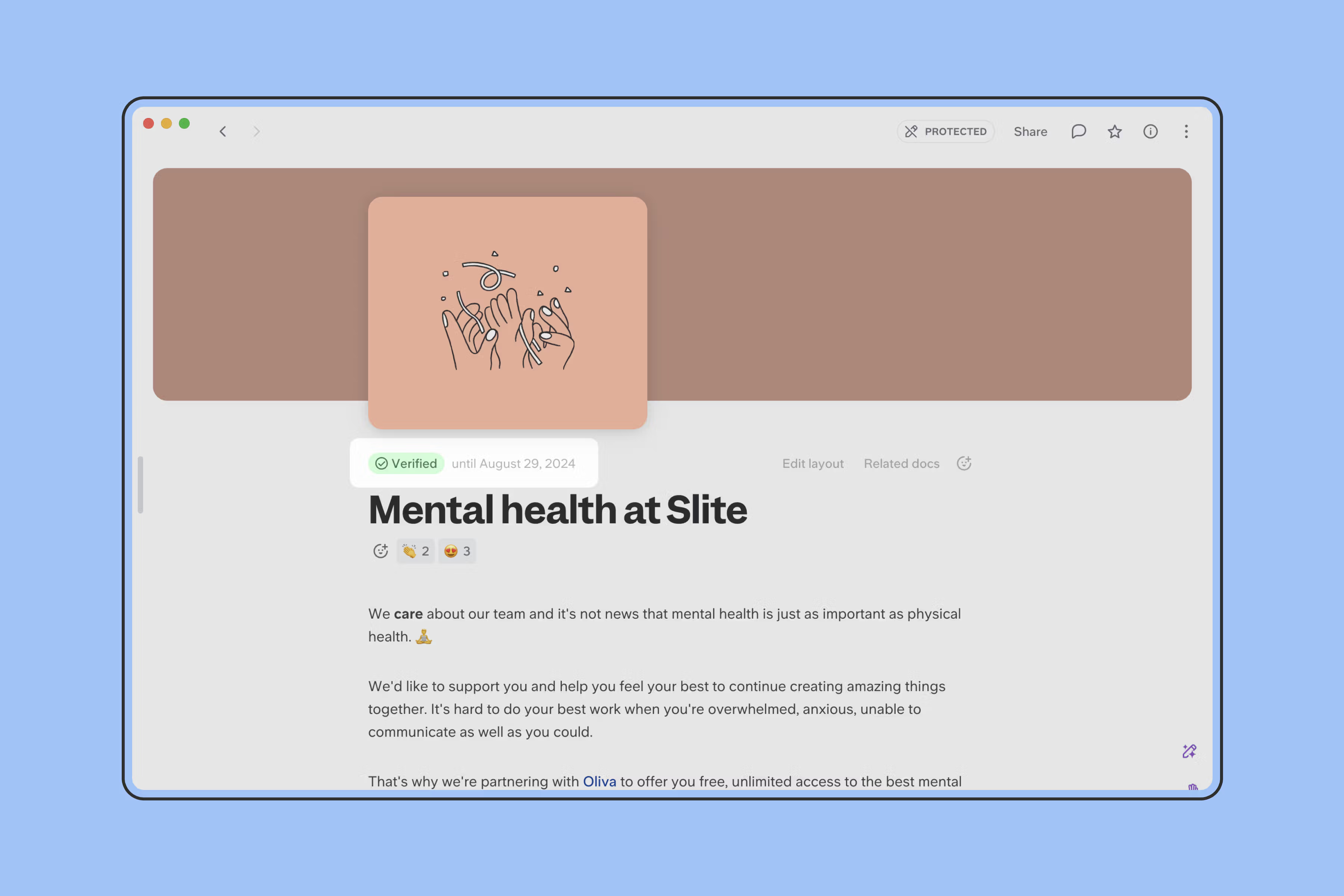
Tip 3 → Give edit access. To everyone.
Your newest employees will be bursting with questions. Ideally, they'd also spend their first weeks just lurking around your Knowledge Base to gather more and more context. This is a unique behaviour to new employees. Existing employees dig back to find specific details whereas new employees dig into your Knowledge Base to explore. Because of it, they're naturally inclined to ask more questions. And they should be able to.
This has helped us a lot in finding gaps in our documentation, actually revisiting and repurpose old ideas, and a lot more.

Tip 4 → Invest in a Knowledge Base Tool
Investing in a Knowledge Base does wonders for the productivity of your top performers. If you're a team of 10-15 people (avg. comp. $25k) with no centralised knowledge, your quick questions will cost you approx. $5,700 every year.
And if you're a team of 20+ people with an avg. mo. comp. $80k, your time lost would be an equivalent to ~$26,000 per year. (You can calculate your exact number using our Time Saving Calculator here!)
And if you're gonna scale your team, are you really comfortable paying $26,000 (or more) every year? We're not, and neither are a lot of teams worldwide. That's why teams invest in a Knowledge Base. But how do you choose one?
"Knowledge management is less of a feature thing, and more of a philosophy thing. There [are] a lot of subtle things that aren't really features. Everyone has a slightly different philosophy on knowledge structure and document structure. And sometimes there's an element of one that feelsright, fits your team, makes sense and aligns with your own philosophy for documentation and Knowledge Bases."
- Mac Reddin, Commsor
And that’s just the tip of the iceberg. Modern Knowledge Bases come with a lot of streamlining features. Like integrations for workflow automation, 2-factor authentication, and clean notifications - all in a user-friendly interface.
If you're looking for an all-in-one solution for a team of <10, you could try any tool from our 2024's list of Top 22 Knowledge Bases.
However, if you're looking for a dedicated Knowledge Base for just Knowledge Management to really nail it, talk to us!

Tip 5 → Check with your Legal Team for Compliance
Ensure that the tool you choose is compliant with your company's legal and security team. Since your Knowledge Base will house confidential data, it's super important that you look for a highly-secure solution and get the required permissions from your legal counsel.
Tip 6 → Monitor the health of your Knowledge Base, and hire a Knowledge Manager when it gets too much
When the employee questions begin to pile up, Knowledge Bases can quickly go out of tune and start showing telltale signs that they need some love. And it happens because initially, Knowledge Management is done by multiple team members handling their own project documentation. That is well and good for smaller companies.
But when you grow faster than you could've imagined, you need scalable processes, handovers, and quick alignment. And that's when your team might need a Knowledge Manager - someone who's full-time gig is to upkeep the company's Knowledge Base.
Tip 7 → Build plug-and-play templates
We've easily built 100+ templates for our team (and our customers, duh!) never have to face the blank page. They cover a variety of use cases like performance management, case management, customer support, employee benefits, FAQs, social media docs, policy documents, and more.
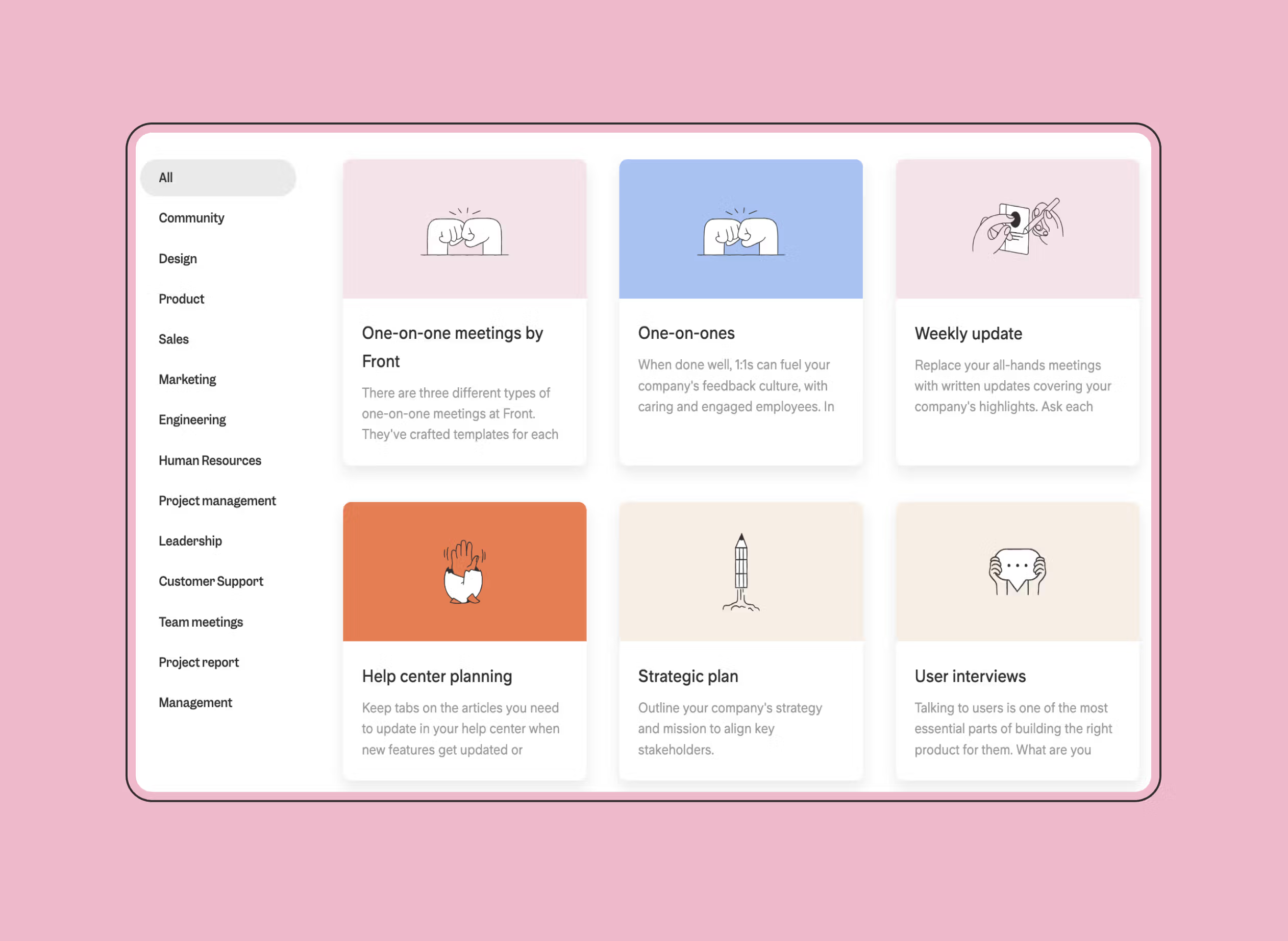
What's more? We've gone another step to customise it just for our own team. Here →
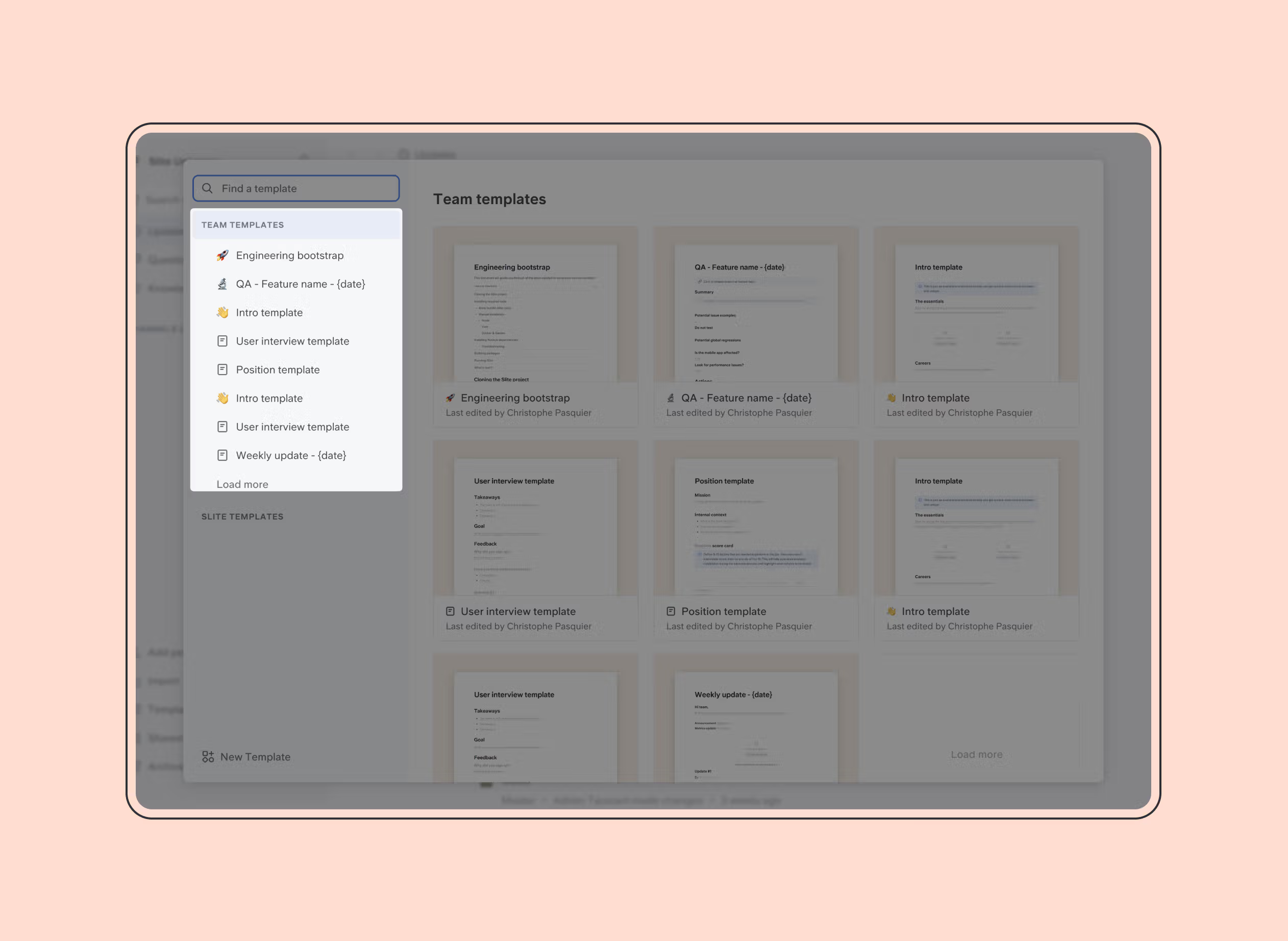
Having plug-n-play templates like these ensure that Slite's team can quickly create new docs to recurring meetings, reports, etc.
Don't believe us? Look at these 5 great HR Knowledge Base Examples
1. Glitch - One of our favourites
Glitch keeps its handbook simple, straightforward and friendly. It doesn't overwhelm people at a first glance and every nested doc is detailed, has bullet points, and highly read-able (and search-able content)
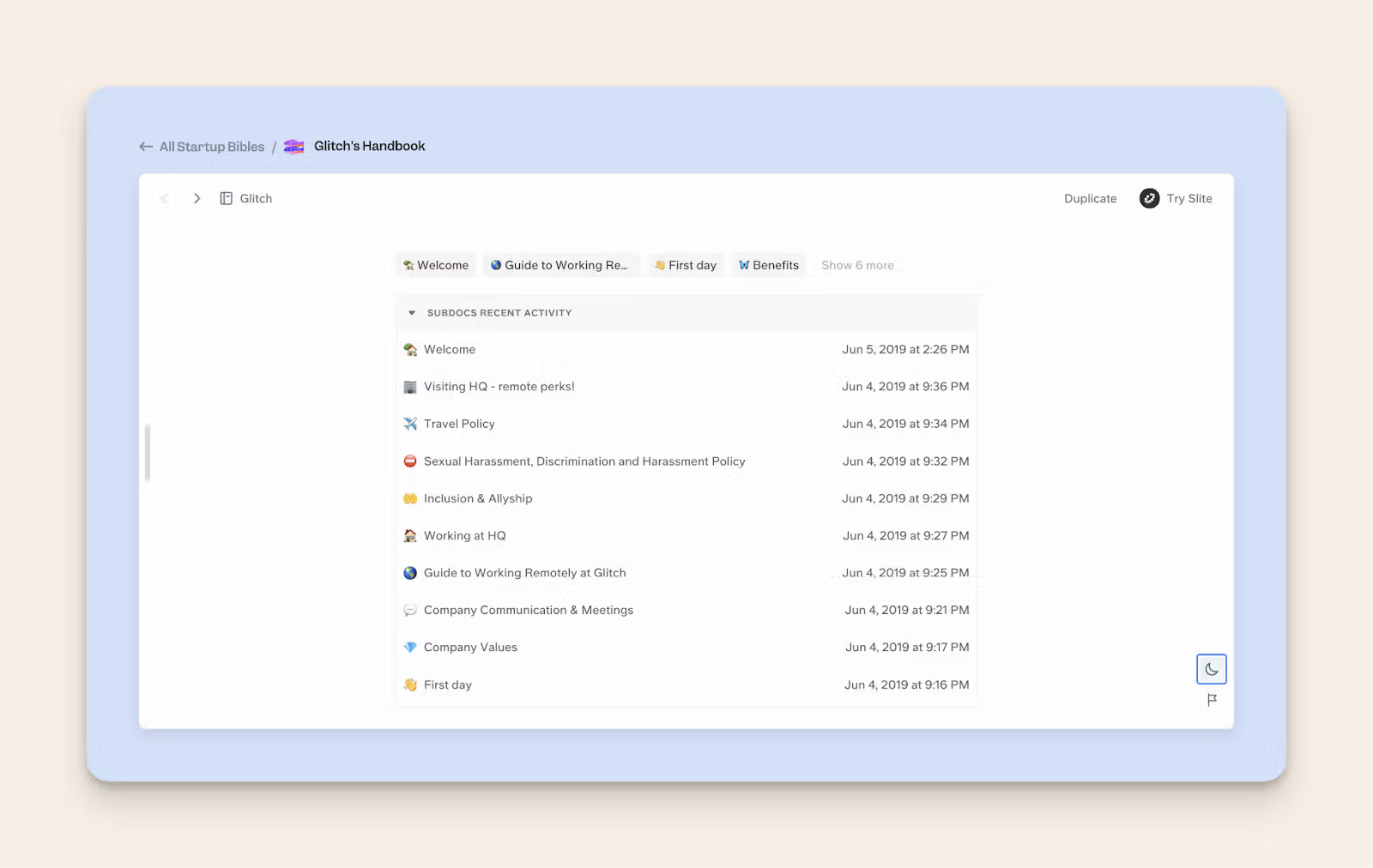
2. MadKudu
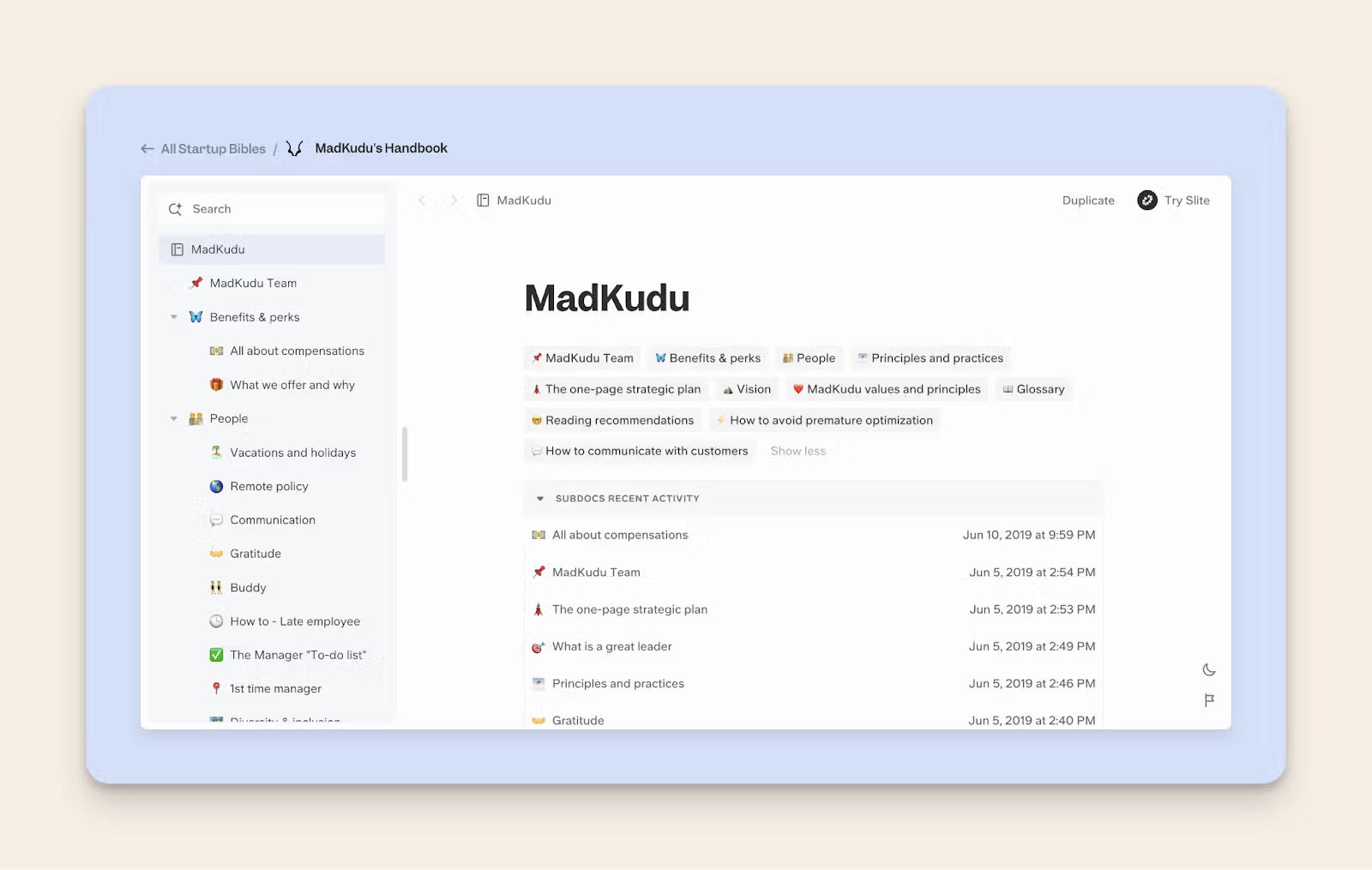
3. Hotjar
Hotjar's 'Working at Hotjar' section is another winner of brevity, media use, and transparency. Not only does it cover everything an HR Knowledge Base should, it does so with an extremely simple tone of voice, with images, tables, and hyperlinks to build a comprehensive handbook.
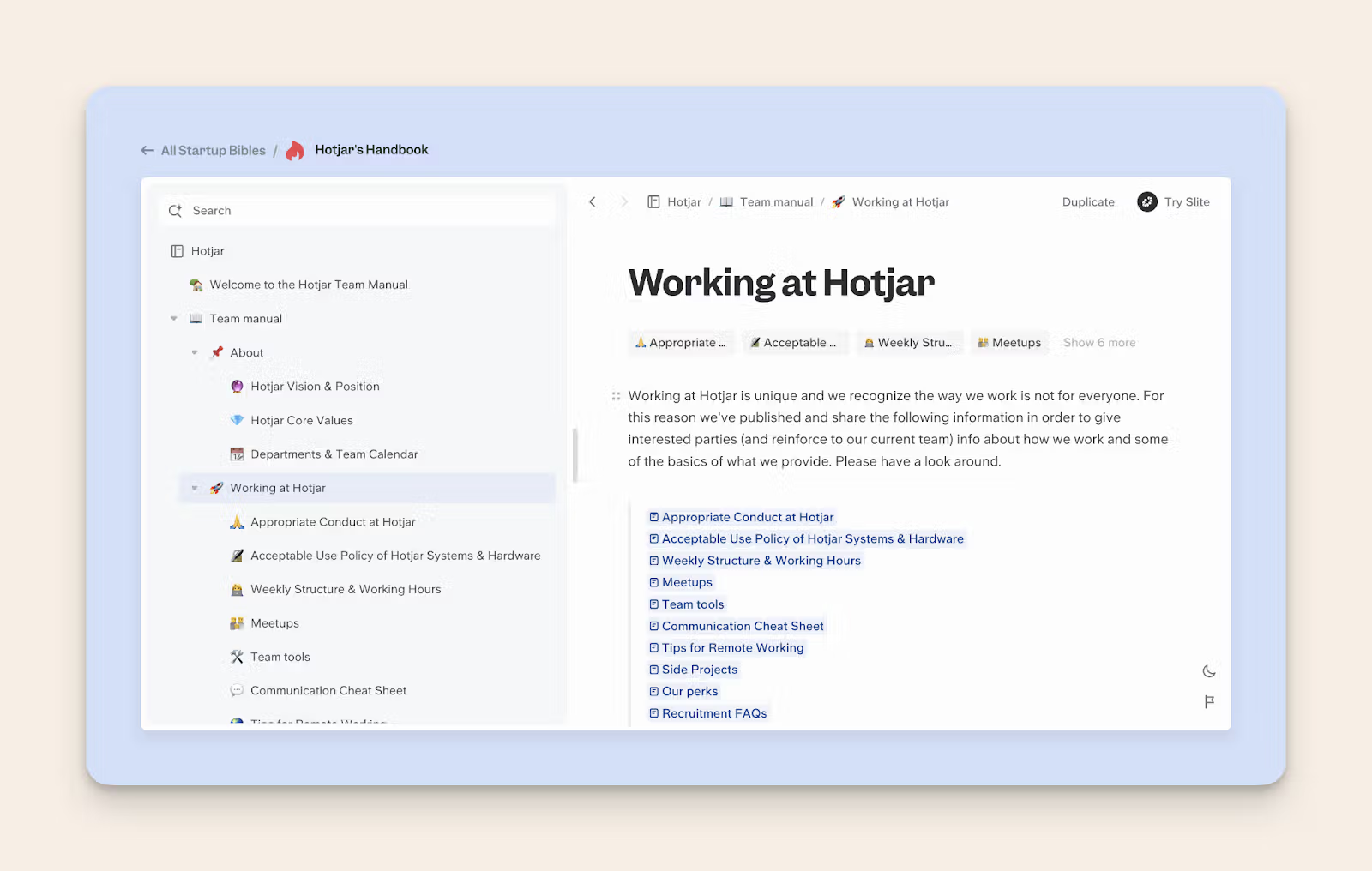
4. Basecamp
Basecamp's HR Knowledge Base covers a lot of ground, comes with an impressively simple structure that simplifies sidebar navigation, and does a great job of setting the brand tone with the employees through their documentation.

5. Remote - Straightforward, no-BS, masterclass in brevity
Rermote's Handbook is a minimal one. You'll see the key sections being covered in one doc each. For example, within the communication section, you can clearly see how they write articulately and clearly state how much they value transparent communication. And we love a company that knows what it cares about!
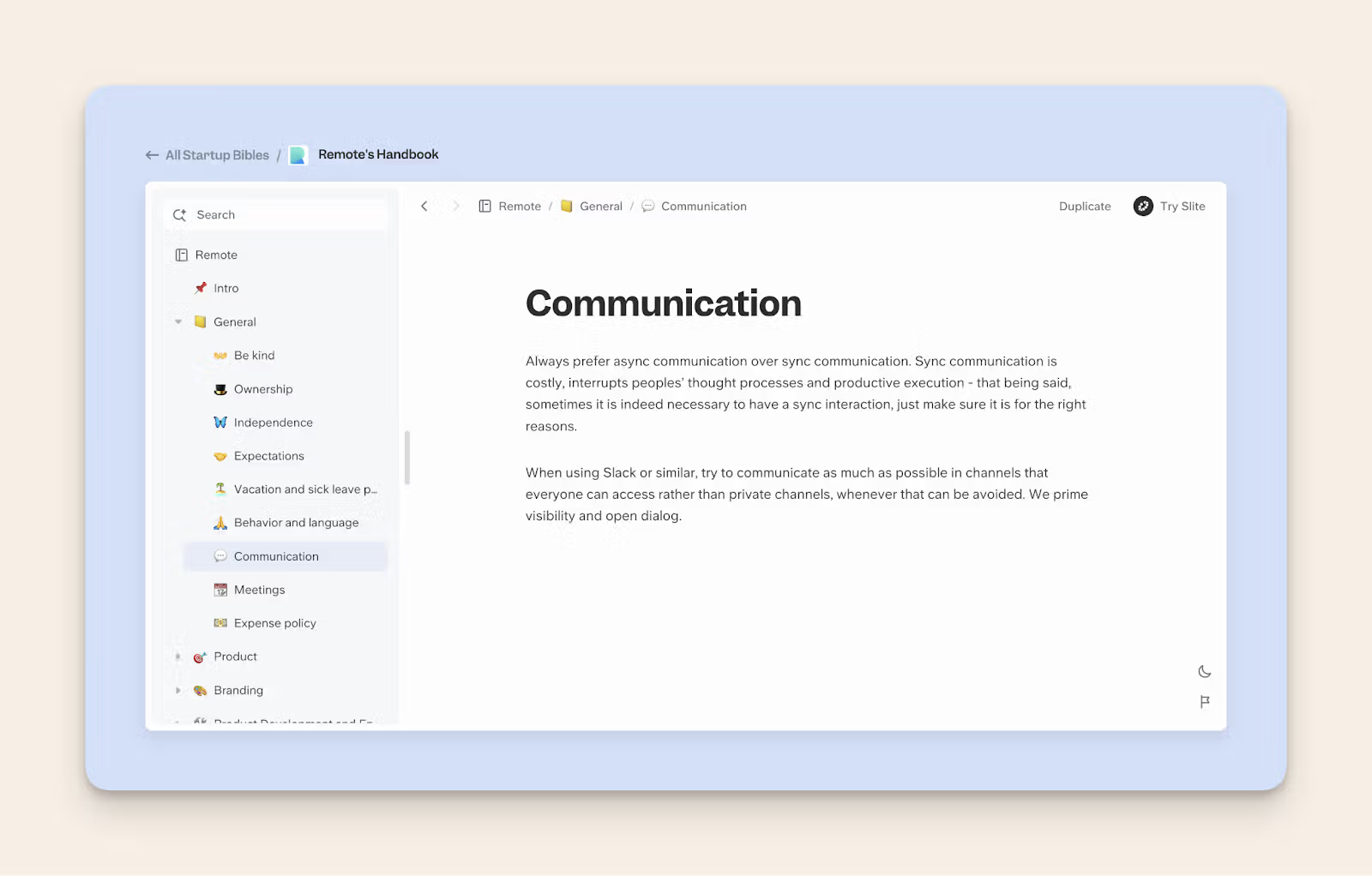
How do you measure the success of your HR Knowledge Base?
You can measure the success of your HR Knowledge Base using doc analytics and the number of incoming HR inquiries. Remember, the primary goal of an HR Knowledge Base is to streamline information access. And if you followed our guide, they'll be viewing your docs and eventually, you'll see a drop in the incoming queries you get from your team members.
Since a Knowledge Base is a constant work in progress, you'll naturally discover knowledge gaps as a team. And it's a great sign. It means that your team cares enough about your documentation to contribute and keep it fresh, albeit via giving you feedback.
As you keep collecting more data, you can ask deeper questions like:
- How has this contributed to employee satisfaction?
- Has this improved employee retention?
- How often is it used in an employee’s onboarding process?
- Has it freed up more time for your HR team?
To conclude, your HR Knowledge Base is only the first step
Remember the HR Handbook we shared at the top? It's only a small piece of our bigger handbook. Human Resources is evolving into People Ops and that means creating a culture that's fair and empowering to every one of your employees.
And that means empowering them in every way - professional and personal. That's why, as you'll see, we've added a bunch of things to our internal Knowledge Base with time. One of the key things you'll see is the focus on our writing culture. Since Slite is a remote and distributed workplace, we make it a point that everyone at Slite's writing to each other.
Similarly, documentation can solve other cultural challenges too. Be it informational silos or un-aligned teams. That's why, we'll always recommend you to write more Knowledge Base articles. We know we do!
And if you need help setting up your company's Knowledge Base, we can help!f
Slite is perfect to build your HR Knowledge Base and extend to building your entire company's documentation. Here's our 3 point-pitch:
- Your team will instantly get how to use it
- We're building Slite as a dedicated Knowledge Base, not an all-in-one - with the best AI capabilities built (for free)
- 200,000+ teams have switched from Notion, Confluence, Guru, etc. to Slite
Want to learn more? Book a demo now.

